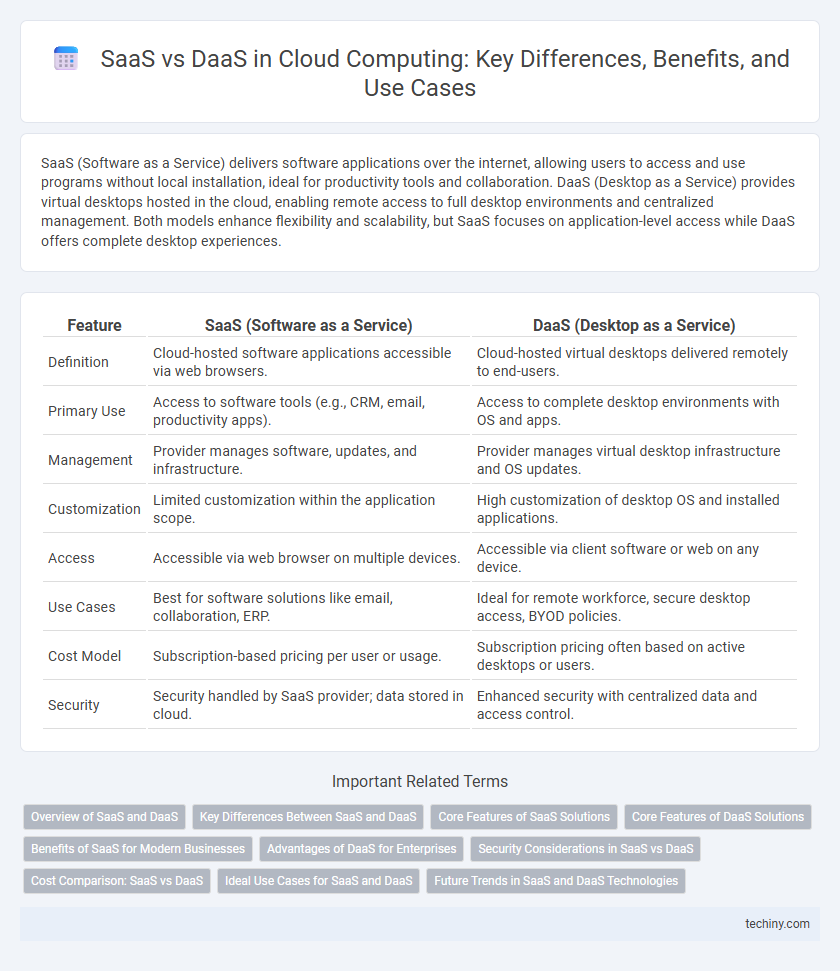SaaS (Software as a Service) delivers software applications over the internet, allowing users to access and use programs without local installation, ideal for productivity tools and collaboration. DaaS (Desktop as a Service) provides virtual desktops hosted in the cloud, enabling remote access to full desktop environments and centralized management. Both models enhance flexibility and scalability, but SaaS focuses on application-level access while DaaS offers complete desktop experiences.
Table of Comparison
| Feature | SaaS (Software as a Service) | DaaS (Desktop as a Service) |
|---|---|---|
| Definition | Cloud-hosted software applications accessible via web browsers. | Cloud-hosted virtual desktops delivered remotely to end-users. |
| Primary Use | Access to software tools (e.g., CRM, email, productivity apps). | Access to complete desktop environments with OS and apps. |
| Management | Provider manages software, updates, and infrastructure. | Provider manages virtual desktop infrastructure and OS updates. |
| Customization | Limited customization within the application scope. | High customization of desktop OS and installed applications. |
| Access | Accessible via web browser on multiple devices. | Accessible via client software or web on any device. |
| Use Cases | Best for software solutions like email, collaboration, ERP. | Ideal for remote workforce, secure desktop access, BYOD policies. |
| Cost Model | Subscription-based pricing per user or usage. | Subscription pricing often based on active desktops or users. |
| Security | Security handled by SaaS provider; data stored in cloud. | Enhanced security with centralized data and access control. |
Overview of SaaS and DaaS
Software as a Service (SaaS) provides users with access to software applications hosted on the cloud, eliminating the need for local installation or maintenance. Desktop as a Service (DaaS) delivers virtualized desktop environments to users, enabling remote access to full desktops via the cloud. Both SaaS and DaaS optimize IT infrastructure efficiency while catering to different user needs--SaaS for application access and DaaS for desktop virtualization.
Key Differences Between SaaS and DaaS
SaaS (Software as a Service) delivers fully functional software applications over the internet, enabling users to access solutions like CRM, email, and collaboration tools without local installation. DaaS (Desktop as a Service) provides virtual desktops hosted on cloud infrastructure, allowing users to access an entire desktop environment remotely with personalized settings and applications. Key differences include SaaS offering specific software access versus DaaS delivering a complete desktop experience, with DaaS emphasizing personalized user environments and SaaS focusing on individual application functionality.
Core Features of SaaS Solutions
SaaS solutions provide scalable software applications hosted in the cloud, offering seamless access through web browsers without the need for local installation or maintenance. Core features include automatic updates, multi-tenancy, and subscription-based pricing models that optimize cost-efficiency and ease of use. Unlike DaaS, which delivers virtual desktop environments, SaaS focuses on delivering specific software functionality directly to end-users over the internet.
Core Features of DaaS Solutions
DaaS solutions provide cloud-based virtual desktops accessible from any device, emphasizing secure remote access, centralized management, and seamless integration with existing IT infrastructure. Core features include persistent user environments, scalable storage, and real-time data synchronization to optimize productivity and data security. Unlike SaaS, which delivers specific applications, DaaS offers a full desktop experience hosted on cloud servers.
Benefits of SaaS for Modern Businesses
SaaS offers modern businesses scalable and cost-effective access to software applications without the need for extensive IT infrastructure or maintenance. Its cloud-based delivery enables seamless updates, enhanced collaboration, and remote accessibility, driving operational efficiency and agility. Organizations benefit from predictable subscription pricing and rapid deployment, accelerating digital transformation and innovation.
Advantages of DaaS for Enterprises
Desktop as a Service (DaaS) offers enterprises enhanced scalability and simplified IT management by delivering virtual desktops accessible from any device, reducing hardware costs and improving remote workforce flexibility. Unlike Software as a Service (SaaS), which provides specific applications, DaaS centralizes desktop environments, ensuring consistent security policies and streamlined updates across the enterprise. This cloud-based model supports seamless disaster recovery and compliance with regulatory standards, making it ideal for businesses with dynamic and geographically dispersed teams.
Security Considerations in SaaS vs DaaS
SaaS security primarily depends on the provider's measures to safeguard data within multi-tenant environments, emphasizing encryption, access controls, and compliance certifications such as SOC 2 and ISO 27001. DaaS offers enhanced security by delivering virtual desktops that isolate user environments, reducing the risk of data breaches on local devices and enabling centralized patch management and endpoint protection. Both models require robust identity and access management, but DaaS provides greater control over user sessions and data residency, critical for organizations with strict regulatory compliance needs.
Cost Comparison: SaaS vs DaaS
SaaS typically offers lower upfront costs due to subscription-based pricing models, minimizing the need for significant hardware investments, whereas DaaS may incur higher expenses linked to virtual desktop infrastructure and ongoing management. Cost efficiency in SaaS comes from centralized application hosting and maintenance handled by providers, reducing IT staff requirements. DaaS expenses often scale with user count and resource allocation, potentially leading to increased operational costs compared to SaaS solutions.
Ideal Use Cases for SaaS and DaaS
SaaS (Software as a Service) is ideal for businesses seeking scalable, web-based applications like CRM, collaboration tools, and email services without the need for local installation or maintenance. DaaS (Desktop as a Service) suits organizations requiring secure, remote desktop environments for employees, enabling access to virtualized desktops and applications from any device, enhancing workforce mobility and centralized management. Both models optimize resource allocation based on the specific needs for software delivery (SaaS) or desktop infrastructure (DaaS).
Future Trends in SaaS and DaaS Technologies
Future trends in SaaS and DaaS technologies emphasize increased integration of artificial intelligence and machine learning to enhance automation, security, and user experience. Adoption of edge computing in DaaS platforms reduces latency, enabling real-time data analytics and seamless access to virtual desktops. Scalability and multi-cloud compatibility will drive innovation, supporting diverse business needs with flexible and cost-efficient cloud solutions.
SaaS vs DaaS Infographic

 techiny.com
techiny.com